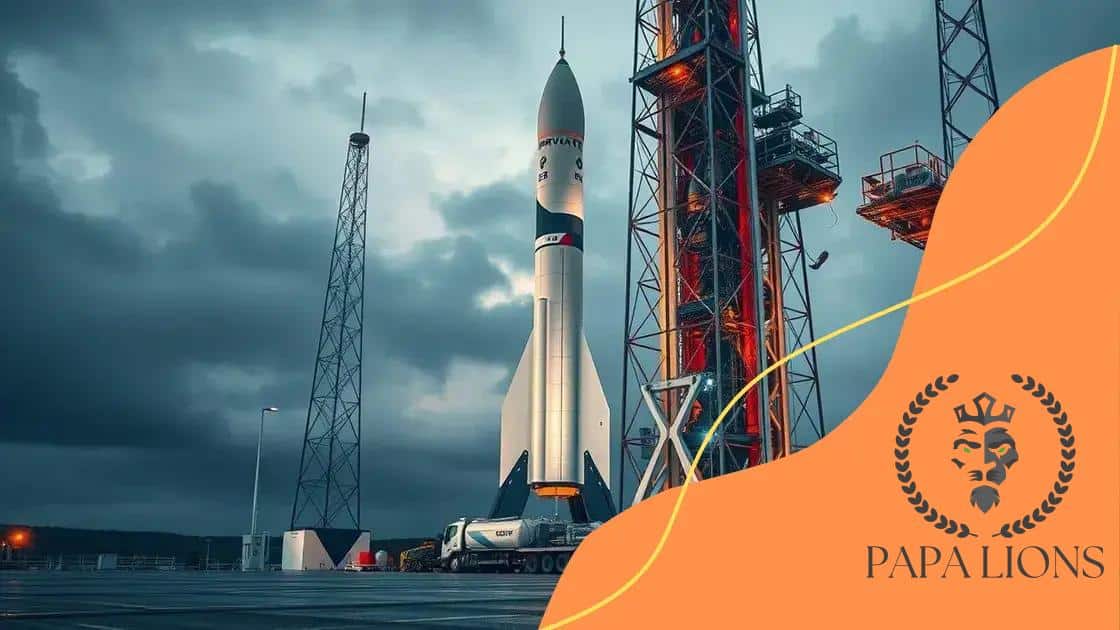Space exploration advancements in 2025 that will amaze you

The future of human habitation in space focuses on creating sustainable environments on Mars and beyond, utilizing advanced technologies and international collaboration to establish permanent human presence in outer space.
Space exploration advancements in 2025 are set to redefine our journey beyond Earth. Imagine uncovering the mysteries of distant planets while revolutionizing space travel. What awaits us in this new era of discovery?
key technologies shaping space exploration
The landscape of space exploration is rapidly evolving. Several key technologies are leading this transformation. They enable us to venture beyond our planet like never before.
Robotic Automation
Automation plays a vital role in space missions. Robotic systems are now responsible for conducting tasks that humans cannot perform in extreme environments. For instance, rovers on Mars gather data and analyze soil samples.
Advanced Propulsion Systems
Another breakthrough is in propulsion technologies. Traditional rockets are being replaced with innovative solutions.
- Ionic thrusters offer efficiency and longevity.
- Nuclear thermal propulsion can drastically reduce travel time to distant planets.
- Solar sails utilize sunlight for propulsion, opening new paths for exploration.
These advancements are revolutionizing our approach to exploring the cosmos. With each new technology, space exploration becomes more achievable and exciting. For example, improvements in satellite technology enhance communication with Earth, ensuring that scientists remain connected.
Moreover, artificial intelligence (AI) is streamlining operations in spacecraft. AI analyzes enormous amounts of data quickly, assisting in real-time decision-making during missions. This capability is essential when dealing with unforeseen challenges in space.
3D Printing
One of the most exciting innovations is 3D printing. This technology allows astronauts to manufacture tools and even structures on demand.
- Reduces the need to carry excessive supplies from Earth.
- Allows for quick repairs in case of malfunctions.
- Facilitates the creation of habitats on other planets.
The integration of these technologies marks a new era of exploration. Each breakthrough brings us one step closer to understanding what lies beyond our planet.
international collaborations in 2025
International collaborations in 2025 are reshaping the future of space exploration. Nations are joining forces to share knowledge, technology, and resources. This teamwork fosters innovation and enhances the potential for successful missions.
Joint Missions
Countries like the USA, Russia, and China are planning joint missions. These collaborations help pool expertise and funding, making ambitious projects more viable.
- Shared resources increase mission capabilities.
- Enables larger and more sophisticated spacecraft.
- Facilitates exchange of scientific data.
By working together, these nations aim to achieve milestones that would be difficult alone. For example, new telescopes and satellites may be developed through these partnerships.
Research and Development
Collaborations also extend to research and development. Scientists from different countries are pooling their insights to tackle challenges.
- Improved technology for space travel.
- Development of sustainable practices in space.
- Creating a robust framework for future exploration.
Sharing knowledge accelerates progress. When experts from various fields contribute, innovative solutions often arise. This dynamic helps address global challenges and achieve common goals.
Moreover, education and training programs are increasingly being organized internationally. These initiatives prepare the next generation of astronauts and engineers. They foster a deeper understanding of space exploration among young people worldwide.
In 2025, more partnerships are expected to emerge, expanding the boundaries of what we can accomplish. Global cooperation opens doors for exploration and discovery that benefit humanity as a whole.
impact of private companies on space travel

The impact of private companies on space travel is significant and growing. In recent years, these companies have transformed the space industry, making exploration more accessible and cost-effective. This shift is changing how we think about space missions.
Innovation and Technology
Private companies are driving innovation. They bring fresh ideas and technologies that challenge traditional methods. For example, advancements in reusable rocket technology are reducing costs and making launches frequent.
- Companies like SpaceX and Blue Origin lead with their reusable rockets.
- Innovative spacecraft designs allow for diverse mission types.
- Technological partnerships enhance research capabilities.
These innovations open up new opportunities for smaller organizations and research institutions. The competition also leads to better services and lower prices, benefiting everyone involved.
Commercialization of Space
The commercialization of space is another major effect. Space tourism is becoming a reality, allowing civilians to experience space travel. More people can now dream of going to space.
- Companies are offering suborbital flights for adventurous travelers.
- Future plans include orbital hotels and lunar tourism.
- This creates new markets and job opportunities.
Additionally, private companies are developing satellites and technologies that aid in global communications and weather forecasting. These efforts enhance our daily lives on Earth and improve our understanding of the planet.
As private investment in space grows, we can expect even greater achievements. The collaboration between government agencies and these companies can lead to exciting missions that push the boundaries of human exploration.
With a focus on sustainability, many private firms are also exploring how to manage space debris, ensuring future generations can enjoy space travel.
exploring new frontiers: Mars and beyond
Exploring new frontiers like Mars and beyond is a thrilling aspect of modern space exploration. The idea of humans setting foot on Mars has moved from science fiction to a near possibility, driven by advancements in technology and research.
Uncovering the Secrets of Mars
Mars holds many mysteries. Scientists believe that this planet once had water on its surface, which could mean it may have supported life.
- Current missions focus on searching for signs of past life.
- Rovers are equipped with advanced tools to analyze soil and rock samples.
- Data from Mars helps us understand its climate and geology.
Researchers are excited about what they can learn from Mars. By studying its landscape, we might find clues about Earth’s history and the potential for life on other planets.
Future Colonization
The long-term goal is to establish a human presence on Mars. It’s more than just visiting; it’s about creating a sustainable habitat.
- Plans include developing technologies for growing food on Mars.
- Living systems will need to recycle air and water.
- Shelters will protect humans from harsh Martian conditions.
This process of colonization involves careful planning and collaboration among nations. With the help of private companies, the dream of living on Mars is becoming more achievable.
Beyond Mars, the search for exoplanets continues. Scientists use powerful telescopes to discover new worlds that could potentially support life. Innovations in space travel may one day allow us to visit these distant planets.
The exploration of the universe is just beginning. Each discovery fuels our imagination and ambition, showing us that there is much more to explore.
future of human habitation in space
The future of human habitation in space is an exciting and ambitious goal. As we look to the stars, establishing sustainable living environments beyond Earth becomes a priority. The advancement of technology plays a crucial role in making this a reality.
Space Habitats
Creating space habitats requires innovative designs and strong materials. These habitats must protect humans from harsh space conditions, including radiation and temperature extremes.
- Modular designs allow for easy assembly and expansion.
- Materials like advanced composites enhance durability.
- Life support systems recycle air and water effectively.
Research is ongoing to develop these habitats. The International Space Station (ISS) provides valuable insights into long-term living in space, helping scientists understand how humans adapt.
Colonization of Other Planets
Colonizing planets like Mars represents a significant step for humanity. It opens possibilities for establishing a permanent human presence beyond Earth.
- Efforts focus on creating sustainable agriculture systems.
- Mining operations might extract resources from other celestial bodies.
- Technologies for energy generation are being developed for off-Earth use.
Utilizing resources found on other planets will be essential. This approach reduces the need to send supplies from Earth, making colonization more feasible.
Moreover, advancements in space travel are reducing the time it takes to reach other planets. New propulsion technologies, like ion engines, offer greater efficiency, paving the way for future exploration.
The vision for human habitation in space goes beyond just survival. It includes thriving societies with culture, community, and governance. As we work towards this future, international cooperation is vital to pool resources and knowledge.
FAQ – Frequently Asked Questions about Human Habitation in Space
What are the main challenges of living on Mars?
The main challenges include extreme temperatures, radiation exposure, and the need for sustainable life support systems.
How will food be grown in space habitats?
Food in space habitats will be grown using hydroponics and vertical farming techniques to maximize efficiency and conserve resources.
What role do private companies play in space exploration?
Private companies contribute innovation, reduce costs, and are often involved in developing technologies needed for long-term space habitation.
Why is international collaboration important for space missions?
International collaboration pools resources, knowledge, and technologies, making ambitious space missions more feasible and effective.





